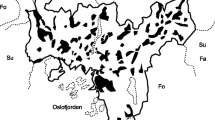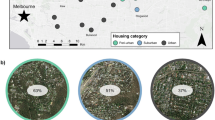Abstract
Urban forest fragments can potentially be ‘habitat islands’ for native birds, but pedestrian traffic could influence the composition and conservation value of their bird assemblages by reducing the representation of disturbance-sensitive species. Winter bird assemblages and pedestrian traffic rates were documented in twelve forested parks in suburban Melbourne, Australia. Native birds comprised 87% of sightings, but two exotic species were common. Bird species' distribution among the parks was significantly nested. However, park rank orders for bird assemblage nestedness and mean pedestrian traffic rate were not correlated and only one species' distribution was nested with respect to this variable. The observed correlation between park area and bird assemblage nestedness may have been partly due to passive sampling. Degree of isolation of parks influenced nestedness less than park area. Forested parks provided habitat for species that occur at intermediate to low densities in other suburban habitats and for ecological specialists otherwise rare in suburbia. Larger parks contained more species than, and many of the native species found in, smaller parks. However, smaller parks each had 25% of the native bird species inhabiting the suite of fragments and thus had both aesthetic value and some potential to enhance city-dwellers' awareness about biodiversity conservation.
Similar content being viewed by others
References
Atmar W, Patterson BD (1993) The measure of order and disorder in the distribution of species in fragmented habitat. Oecologia 96:373–382
Atmar W, Patterson BD (1995) The nestedness temperature calculator: A visual basic program, including 294 presence-absence matrices. AICS Research Inc., University Park, NM and Field Museum, Chicago, Illinois
Barret G, Silcocks A, Barry S, Cunningham R, Poutlter R (2003) The New Atlas of Australian Birds. RAOU, Hawthorn East, Melbourne
Blumstein DT (2003) Flight-initiation distance in birds is dependent on intruder starting distance. J Wildl Manage 67:852–857
Bolger DT, Alberts AC, Soulé ME (1991) Occurrence patterns of bird species in habitat fragments: Sampling extinction and nested species subsets. Am Nat 137:155–166
Burger J, Gochfeld M (1991) Human disturbance and birds: tolerance and response differences of resident and migrant species in India. Environ Conserv 18:158–165
Catterall CP (2004) Birds, garden plants and suburban bushlots: Where good intentions meet unexpected outcomes. In: Lunney D, Burgin S (eds) Urban Wildlife: More than meets the eye. Royal Zool. Soc. New South Wales, Mosman, NSW, pp. 21–31
Catterall CP, Green RJ, Jones DN (1989) Occurrence of birds in relation to plants in a subtropical city. Aust. Wildl Res 16:289–305
Catterall CP, Piper SD, Goodall G (2002) Noisy miner irruptions associated with land use by humans in southeast Queensland: Causes, effects and management implications. In: Franks A, Playford J, Shapcott A (eds) Landscape health of Queensland, Proc. Roy. Soc. Queensland, Brisbane, pp.117–127
Clarke KL (1993) Non-parametric multivariate analysis of change in community structure. Aust J Ecol 18:117–143
Cook R, Quinn JF (1995) The influence of colonization in nested species subsets. Oecologia 102:413–424
Cooke AS (1980) Observations on how close certain passerine species will tolerate an approaching human in rural and suburban areas. Biol Conserv 18:85–88
Deutschweitz K, Lausch A, Kuehn I, Klotz S (2003) Native and alien plant species richness in relation to spatial heterogeneity on a regional scale in Germany. Glob Ecol Biogeogr 12:299–311
Fernandez-Juricic E (2000) Bird community patterns in urban parks of Madrid: The role of age, size and isolation. Ecol Res 15:373–383
Fernandez-Juricic E (2001) Avian spatial segregation at edges and interiors of urban parks in Madrid, Spain. Biodivers Conserv 10:1303–1316
Fernandez-Juricic E (2002) Can human disturbance promote nestedness? A case study with breeding birds in urban habitat fragments. Oecologia 131:269–278
Fernandez-Juricic E, Jimenez MD, Lucas E (2001) Alert distance as an alternative measure of bird tolerance to human disturbance: implications for park design. Environ Conserv 28:263–269
Fernandez-Juricic E, Jokimäki J (2001) A habitat island approach to conserving birds in urban landscapes: case studies from southern and northern Europe. Biodivers Conserv 10:2023–2043
Fernandez-Juricic E, Telleria JL (2000) Effects of human disturbance on Blackbird Turdus merula spatial and temporal feeding patterns in urban parks of Madrid, Spain. Bird Study 47:13–21
Fischer J, Lindenmayer DB (2002) Treating the nestedness temperature calculator as a “black box” can lead to false conclusions. Oikos 99:193
Fleishman E, Murphy DD (1999) Patterns and processes of nestedness in a Great Basin butterfly community. Oecologia 119:133–139
Gill AM, Williams JE (1999) Fire regimes and biodiversity: the effects of fragmentation of southeastern Australian eucalypt forests by urbanization, agriculture and pine plantations. For Ecol Manage 85:261–278
Gill JA, Sutherland WJ, Watkinson AR (1999). A method to quantify the effects of human disturbance on animal populations. J Appl Ecol 33:786–792
Gray M, Knight J (2001) Flora of Melbourne: A guide to the indigenous plants of the greater Melbourne area, 3rd edn. Hyland House, South Melbourne, Australia
Green RJ (1984). Native and exotic birds in a suburban habitat. Aust Wildl Res 11:181–190
Grey MJ, Clarke MF, Loyn RH (1998) Influence of the Noisy Miner Manorina melanocephala on avian diversity and abundance in remnant grey box woodland. Pac Conserv Biol 4:55–69
Grover DR, Slater PJ (1994) Conservation value to birds of remnants of Melaleuca forest in suburban Brisbane. Wildl Res 21:433–444
Gutzwiller KJ, Anderson SH (1999) Spatial extent of human-intrusion effects on subalpine bird distributions. Condor 101:378–389
Gutzwiller KJ, Marcum HA, Harvey HB, Roth JD, Anderson SH (1998) Bird tolerance to human intrusion in Wyoming montane forests. Condor 100:519–527
Hecnar SJ, M’Closkey RT (1997) Patterns of nestedness and species association in pond-dwelling amphibian fauna. Oikos 80:371–381
Hecnar SJ, Casper GS, Russell RW, Hecnar DR, Robinson JN (2002) Nested species assemblages of amphibians and reptiles on islands in the Laurentian Great Lakes. J Biogeogr 29:475–489
Huhtalo H, Jarvinen O (1977) Quantitiative comparison of the urban bird community in Torni, Northern Finland. Bird Study 24:179–185
Jokimäki J (1999) Occurrence of breeding bird species in urban parks: Effects of park structure and broad-scale variables. Urban Ecosyst 3:21–34
Jones DN (1981) Temporal changes in the avifauna of an inland city. Aust Wildl Res 8:109–19
Kadmon R (1995) Nested species subsets and geographical isolation: A case study. Ecology 76:458–465
Klein LM, Humphrey SR, Percival HF (1995) Effects of ecotourism on distribution of waterbirds in a wildlife refuge. Conserv Biol 9:1454–1465
Knight RL, Cole DN (1995) Factors that influence wildlife responses to recreationists. In: Knight RL, Gutwiller KJ (eds) Wildlife and recreationists: Coexistence through management and research. Island Press, Washington DC, pp. 71–79
Lenz M (1990). The breeding bird communities of three Canberra suburbs. Emu 90:145–153
Mac Nally, R Bennett, AF, Horrocks G (2002) Nestedness in fragmented landscapes: Birds of the box-ironbark forests of southeastern Australia. Ecography 25:651–660
Maron M, MacNally R, Watson DM, Lill A (2004) Can the biotic nestedness matrix be used predictively? Oikos 106:433–444
Martin JL, Gaston AJ, Hitier S (1995) The effect of island size and isolation on old growth forest habitat and bird diversity in Gwaii Haanas (Queen Charlotte Islands: Canada). Oikos 72:115–131
McDonald K, Brown J (1992). Using montane mammals to model extinctions due to global change. Conserv Biol 6:409–415
Natuhara Y, Imai C (1999) Prediction of species richness of breeding birds by landscape-level factors of urban woods in Osaka Prefecture, Japan. Biodivers Conserv 8:239–253
Nilon CH, Pais RC (1997) Terrestrial vertebrates in urban ecosystems: Developing hypotheses for the Gwynns Falls Watershed in Baltimore, Maryland. Urban Ecosystems 1:247–257
Parsons H, French K, Major RE (2003) The influence of remnant bushland on the composition of suburban bird assemblages in Australia. Landsc Urban Plan 66:43–56
Patterson BD, Atmar W (1986) Nested subsets and the structure of insular mammalian faunas and archipelagos. Biol. J Linn Soc 28:451–463
Patterson BD, Atmar W (2000) Analyzing species composition in fragments. In: Rheinwald G (eds) Isolated vertebrate communities in the tropics, Proceedings 4th International Symposium, Bonn Zool Monogr 46:1–16
Platt A (2003) Influence of human traffic on nestedness of bird communities in urban wooded parks. Honours thesis, Monash University, Melbourne, Australia
Riffell SK, Gutzwiller KJ, Anderson SH (1996). Does repeated intrusion cause cumulative declines in avian richness and abundance? Ecol Applic 6:492–505
Ruiz G, Rosenmann M, Novoa FF, Sabat P (2002) Hematological parameters and stress index in rufous-collared sparrows dwelling in urban environments. Condor 104:162–166
Schodde R, Faith DP (1990) The development of modern avifaunulas. Acta XX Congr Int Ornithol 1:404–412
Schoener TW (1968) Sizes of feeding territories among birds. Ecology 49:123–141
Schoener TW, Schoener A (1983) Distribution of vertebrates on some very small islands. I. Occurrence sequences of individual species. J Anim Ecol 52:209–235
Simberloff DS, Abele LG (1982) Refuge design and island biogeographic theory: Effects of fragmentation. Am Nat 120:41–50
Simberloff D, Martin JL (1991) Nestedness of insular avifaunas: simple summary statistics masking complex species patterns. Ornis Fenn. 68:178–192
Tilghman NG (1987) Characteristics of urban woodlands affecting breeding bird diversity and abundance. Landsc Urban Plan 14:481–495
van der Zande AN, Vos P (1984) Impact of a semi-experimental increase in recreation intensity on the density of birds in groves and hedges on a lake shore in The Netherlands. Biol.Conserv. 30:237–259
van der Zande AN, Berkhuizen JC, van Latesteijn HC, ter Keurs WJ Poppelaars AJ (1984) Impact of outdoor recreation on the density of a number of breeding bird species in woods adjacent to urban residential areas. Biol Conserv 30:1–39
Vandruff LW, Leedy DL, Stearns FW (1995) Urban wildlife and human well-being. In: Sukopp H, Numata M, Huber A (eds) Urban ecology as the basis for urban planning. SPB Academic Publishing, The Hague, Netherlands
van Polanen Petel T, Lill A (2004) Bird communities of some urban bushland fragments: implications for conservation. Aust Field Ornithol 21:21–32
Weddell BJ (2002) Conserving living natural resources in the context of a changing world. Cambridge University Press, Cambridge, UK
Wright SP (1992) Adjusted P-values and simultaneous inference. Biometrics 48:1005–1013
Wright DH, Patterson BD, Mikkelson GM, Cutler A, Atmar W (1998) A comparative analysis of nested subset patterns of species composition. Oecologia 113:1–20
Wright DH, Reeves JH (1992) On the meaning and measurement of nestedness in species assemblages. Oecologia 92:416–428
Author information
Authors and Affiliations
Corresponding author
Rights and permissions
About this article
Cite this article
Platt, A., Lill, A. Composition and conservation value of bird assemblages of urban ‘habitat islands’: Do pedestrian traffic and landscape variables exert an influence?. Urban Ecosyst 9, 83–97 (2006). https://doi.org/10.1007/s11252-006-7900-6
Published:
Issue Date:
DOI: https://doi.org/10.1007/s11252-006-7900-6




